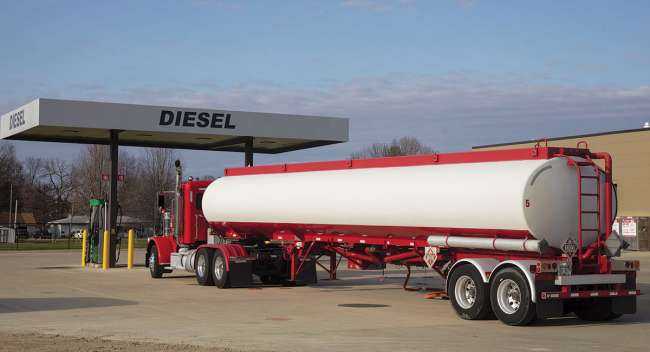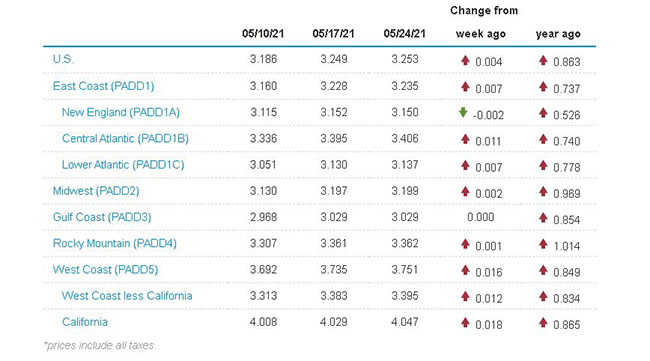Diesel Up Slightly as Summer Travel Season Kicks Off

[Stay on top of transportation news: Get TTNews in your inbox.]
The national average price for a gallon of diesel nudged up just four-tenths of a cent to $3.253 a gallon, according to Energy Information Administration data released May 24.
AAA forecasts Memorial Day weekend will see 34.7 million motorists traveling 50 miles or more over the holiday, a 60% increase over the 23 million measured against the COVID-19 slump of 2020. That figure was the lowest on record since the group began keeping that statistic. Still the AAA figure is 6 million less than in 2019, when more than 40 million people took trips.
With more people on the road, prices could inch up, at least temporarily. Fuel-tracking analytic company GasBuddy expects gas to remain in the upper $2-per-gallon range or even low $3-per gallon-range as the summer months approach.
Highlights
• This week’s modest gain came after the price of trucking’s main fuel increased 12.5 cents a gallon over the previous three weeks.
• Diesel now costs 86.3 cents more than it did at this time a year ago.
• Diesel has increased four consecutive weeks after remaining unchanged at $3.124 on April 26. Before that, the price had declined for four consecutive weeks for a total of 7 cents dating to March 22.
• The average cost of a gallon of diesel increased in eight of the 10 regions in EIA’s weekly survey, decreased by two-tenths of a cent in New England and was unchanged in the Gulf Coast. The biggest rise was 1.8 cents in California.
• Meanwhile, the average price of gasoline took a downward turn, shedding eight-tenths of a cent to settle at $3.02 a gallon.
Tom Kloza, founder of the Oil Price Information Service, told Transport Topics that Memorial Day weekend is not so much a launch date for the summer peak driving season but rather a “dress rehearsal” for the next three to four months — the highest fuel consumption period for the year.
“Fuel prices are going sideways for now,” Kloza said. “There was certainly a hangover from the tank topping of the seven or eight days the Colonial Pipeline was shut down. If we get through Memorial Day without any craziness, spreading rumors you need to fill up and people panicking, then I think we’re in for a bit of a reprieve.”
He said that traditionally right after Memorial Day gas demand falls for several weeks as students return to school for their last week of classes and families don’t travel as much. But Kloza added that if the U.S. experiences a stronger than normal hurricane season as forecasters have been saying could happen, the summer could see spot gasoline and diesel shortages.

Kloza
“If we have hurricanes in the Gulf of Mexico in July and August, you’ll hear people saying, ‘They say we could run low on fuel,’ ” Kloza said. “People have been inside for a year and not being able to go about normal things, I think it has created crazy things in the aggregate, and it means they’re more prone to doing crazy things in the crowd.”
According to Patrick DeHaan, head of petroleum analysis at GasBuddy, parts of the eastern U.S. still are recovering from the Colonial Pipeline shutdown, and restoring regional supplies has been hampered by a shortage of truck drivers to deliver petroleum products to retailers.
DeHaan said gas prices already are at six-year highs, and some stations in the Southeast and Mid-Atlantic could see shortages until the pipeline situation is resolved, likely in a few weeks.
“Motorists will likely be digging a bit deeper this summer than they have in past years, fueled by COVID recovery and gasoline demand that has surged,” DeHaan said. “This summer could see hot gasoline demand and while prices are unlikely to break records, the national average may hover between $2.75 to $3.25 per gallon for a majority of the summer, and should there be unexpected outages, it could be made worse by the truck driver shortage and pinch prices more than anticipated.”

EIA.gov
For most of May, the price of oil has remained stable, sitting in a range of $65 to $67 a barrel. West Texas Intermediate, the industry benchmark, closed at $66.21 on May 25.
While oil production decreased dramatically in 2020 because of the pandemic, the Energy Information Administration reported last week U.S. oil producers pumped 11 million barrels per day. EIA’s latest Short-Term Energy Outlook says U.S. domestic oil production is increasing and is forecast to reach 11.3 million barrels per day in the fourth quarter, then average 11.8 million barrels in 2022.
In late 2019 and early 2020, the U.S. reached nearly 13 million barrels per day, overtaking, at least temporarily, Saudi Arabia and Russia as the world’s top oil-producing nation.< p/>
Want more news? Listen to today's daily briefing below or go here for more info:

